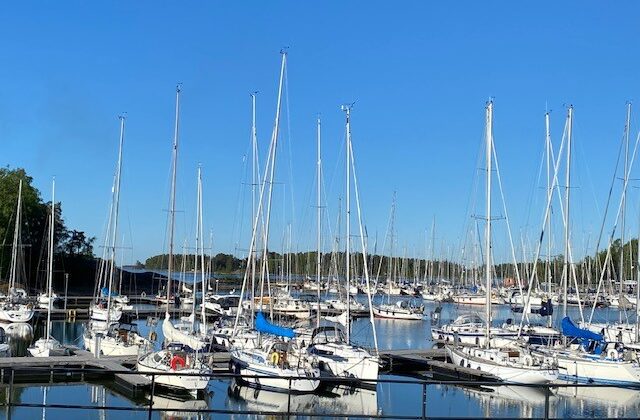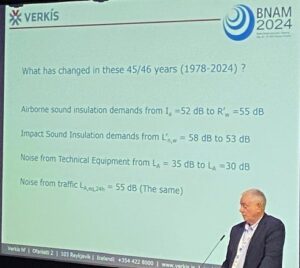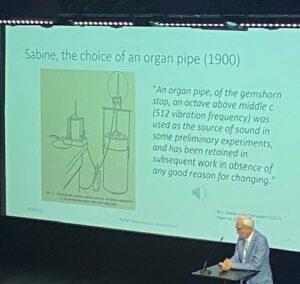
On May 22-24, some 175 delegates from 18 countries gathered together in the beautiful venue at the Finnish-Swedish Cultural Center Hanaholmen. Located at the scenic seafront between Helsinki and Espoo in Finland. Three days of conference targeted even more than before to the people practising acoustics every day. This meant that one of the Baltic-Nordic Acoustic Meeting conference days was dedicated to tutorials/courses/software demonstrations and the remaining two days focused on presentations of papers.
Key note speakers at the Baltic-Nordic Acoustic Meeting

The event had a lovely start with a Key Note presentation by Steindór Gudmundsson – Acoustic regulations and quality classes. Experience from over 35 years of collaboration in the Nordic countries
In 2014 Jens Holger Rindel presented the paper The History of the Nordic Acoustic Association in the NAA 60th Anniversary book. The information about the early years of Nordic collaboration in acoustics stems partly from this paper. Already in 1960 the first proposal for common Nordic requirements on sound insulation was presented by NKB (The Nordic Committee on Building Regulations). In 1973 a NKB acoustic working group was established. And in 1974 the group delivered recommendations that were adopted in the national Nordic building regulations. Finally in 1978 NKB presented the report: “Guidelines for building regulations concerning sound precautions”.
These guidelines were used when a new Icelandic building code was published in 1979. Including acoustic demands in the building code for the first time. Then, all the Nordic building codes were almost identical regarding acoustics. Some European countries had somewhat stricter regulations than the Nordic countries. As a result, an acoustic working group was established again within NKB in 1993 with the task to suggest new harmonised sound insulation demands for residential buildings.
Soon after 2000, the Nordic countries published different national classification standards. They have since developed and although they are similar in many ways, they are not identical. Thank you Steindór for the nice retrospect on how it all started!
Room acoustic measurement methods in the past, present and future, including the importance of the ISO 3382 series, by Jens Holger Rindel

This presentation gave a brief overview of room acoustic measurements and how the methods have developed during the last 125 years. Wallace C. Sabine (1868-1919) is known as founder of room acoustic measurements around 1900. He introduced the concept of reverberation time, defined as the time for the sound intensity in a room to decay to 1/1.000.000 of the initial intensity after a sound source is turned off.
The measurements were performed with specially constructed organ pipes as sound sources and a chronograph (stopwatch) to measure the audible decay time. The organ pipes were of the type gemshorn, which has a strong fundamental tone and relatively weak overtones. Sabine could calculate the reverberation time related to 60 dB decay.
We were presented with some old, classical images of Mr.Sabine sitting in his box for these measurements such a long time ago. A very charming speech overlooking history!
Finnish standard at the Baltic-Nordic Acoustic Meeting
Revised Finnish standard SFS 5907:2022 on acoustical design and quality classes of buildings, by Mikko Kylliäinen, Simo Laitakari and Timo Huhtala
SInce we are hosted by Finland it´s appropriate to also mention the presentation on the quite recently revised acoustic standard. The second edition of the Finnish standard SFS 5907 was published in December 2022. Several sections and definitions of the first edition (2004) had gone out of date. The classification system introduced in 2004 consisting of four acoustical classes had also turned out to be too detailed. Thus, the second edition of the standard introduces a new classification system consisting of three acoustical classes.
Another major change is updating the single number quantities for sound insulation. Both the requirements for airborne and impact sound insulation are now given as standardized values DnT,w and L’nT,w + CI,50-2500. In the second edition, special attention has been paid to the limiting values for railway induced vibration. Also ground-borne noise in different buildings, like apartments, hospitals, schools, and office buildings.
The revision has brought the standard and its scientific basis to the state-of-the-art level of present knowledge on building acoustics. Its impact on the construction industry in Finland and acoustic design of buildings will be significant. During the year and a half since the publication of the standard, it has been used as a guideline for the acoustical goals of the projects, in preliminary design phases. And as a reference material in design competitions of different project types.
The presentation from BNAM2024 can be found here.
Would you like to read more on previous BNAM conferences, check these links out!

